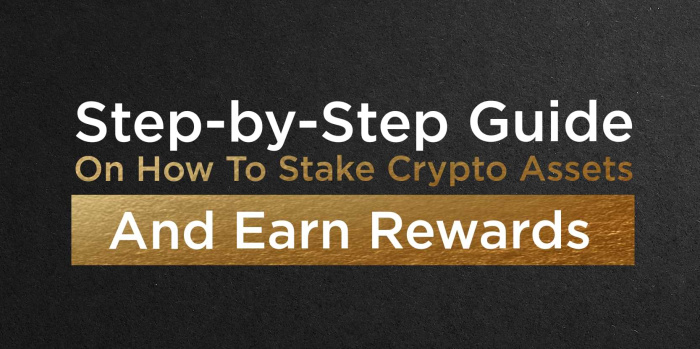
Step-by-Step Guide On How To Stake Crypto Assets And Earn Rewards
The easiest way to obtain cryptocurrencies is by purchasing them from an exchange, where you essentially trade fiat money for digital coins. But in the first place, how are cryptocurrencies minted?
Most cryptocurrencies are typically created through mining or staking. Bitcoin is one example of a coin that can be mined. It’s a process that requires sophisticated computers to solve complex math problems to produce more coins for use within the network. The process has grown increasingly competitive as other miners join, making it difficult for beginners or hobbyists without access to cheap power and expensive equipment from joining this method of obtaining cryptocurrency assets.
On the other end of the scale, staking crypto is a less resource-intensive process that involves delegating several coins onto the network and leaving them for a predetermined period. The coins produce a certain amount of rewards over time that can be claimed as they are made available. The process is automated through an open-source staking platform and doesn’t require you to leave your computer turned on to accumulate assets.
What Can I Stake?
It’s only possible to stake in networks with the Proof-of-Stake algorithm or any of its derivatives. A stake defines your percent contribution to the network at a particular cycle, and rewards and distributed based on individual systems unique to each blockchain protocol.
Ethereum 2.0 (ETH)
Ethereum is currently transitioning to 2.0, a process that requires the help of the community through staking. By contributing to the network, you can become a validator that secures the network while earning passive rewards. Start by heading to the Eth2 Launchpad, which has all the resources you need to become a network validator. However, to start Ethereum staking, a minimum stake of 32 ETH is required, and your coins will be locked into the blockchain until the transition is complete—at the moment, there is no designated date for that to happen. While there's a risk in joining, the reward prospects are also huge, considering how each ETH hovers above $2,500 and has peaked at $4,400.
Tezos (XTZ)
Tezos’s unique staking process is called “baking” and is a highly monitored process that penalizes cheaters, hackers, and other foul players by depriving them of coin earnings. Tezos staking is an expensive affair—you need a minimum of 8,000 XTZ to qualify. As each Tezos (XTZ) currently goes for over $3.8, staking entails a $30,000 investment to start.
On the bright side, staking pools have emerged for small-scale stakers, allowing you to put in any amount of XTZ on top of a minimal fee. The pool organizer then delegates rewards based on the agreed-upon division—usually based on your percent contribution to the pool.
Icon (ICX)
The icon is a company with ambitions to build "a sharding network that scales." Like EOS, it employs the Delegated Proof-of-Stake consensus model, a highly controversial model for its lack of decentralization. The community delegates coins to a select number of members chosen to validate blocks on the network. Rewards are high and can range from 6-36% annually, but gaining power in this network is difficult if you're not a well-known member.
Algorand (ALGO)
Algorand (ALGO) uses a Proof-of-Stake algorithm to allow for scaling as the network matures. By joining the staking system, you become the node owner and are then rewarded with transaction fees and newly minted coins—a reward that decreases over time. However, if you don’t fancy running a full node on your own, it’s also possible to join a staking pool, some of which delegate considerable rewards.
Where Can I Start Staking?
There are various platforms where you can start staking and third-party services that offer staking pools for you to join if you don't have a large number of coins to work with.

Exchanges
Exchanges like Binance and Coinbase offer staking services for some of the coins they support. For example, you can stake Bitcoin Cash (BCH) from your Coinbase account and enjoy a reward in the form of newly minted BCH tokens after every 210 blocks have been validated. Exchanges like KuCoin also offer to stake rewards with their referral program, where users earn up to 30% commission on trading fees by referring other traders to an exchange that offers this feature.
Each exchange offers different annual rewards for each coin—it’s best to shop around and explore your options before committing to one, and consider diversifying the location of your stakes to get the best-earning power possible.
Third-Party Services
Staking pools are groups made up of members who pool funds together to not rely only on themselves when it comes time to validate transactions. They instead share these responsibilities among members within the group—something which is more feasible if stakes are small or there’s no one with a stake big enough to validate transactions.
Some third-party websites will even allow you to invest in staking opportunities without first owning an altcoin, meaning that they’ll handle all facets of your investment for you and just send over any rewards earned from validating blocks found by the network during mining sessions (though this can come at the expense of high service fees). The biggest downside to third-party pools is that many of them are scams: you need to be vigilant in finding legitimate sites that won’t run away with your coins.
Online & Offline Wallets
Some blockchains have native online wallets that allow you to stake directly from the platform, so you don't have to figure out a complex coin-transfer ecosystem for receiving rewards, reducing the risk of error. Cardano's Daedalus Mainnet is one such example—it allows you to use regular wallet functions while also staking ADA from the same software.
Some offline wallets have crypto staking support, making them wonderful options for keeping your funds safe, especially when dealing with a substantial stake. Ledger and Trezor, two industry leaders in cryptocurrency cold storage, allow staking crypto—though you may need to connect with their online partner. For instance, if you use Trezor, you'll need to perform the stake on Exodus but can receive funds through Trezor.
Risks of Staking
Staking coins involves less risk than mining, as you don’t need massive capital investment to get started. However, it also isn’t a risk-free venture. In particular, you need to be ready to swallow losses incurred by the volatile market. As your coins are locked into the stake or pool, you won’t always be able to withdraw them (especially if a lock-in period was stated in the protocol). If the coin’s price were to plummet within that period and doesn’t recover, then you won’t have an immediate income to profit from. As a result, staking crypto is often recommended only for HODLers willing to leave their funds alone for a long time.
Another risk in this venture is not calculating the cost vs. risk and profit, which can net you with losses instead of gains. Stakes that are too small are unlikely to bring in any tangible profit—for instance, staking 2 ADA might not get you more than a few cents per year. If you have an annual coin profit target, you can use a staking calculator to determine the possible rewards against time and other costs (such as electricity and pool fees).
How to Earn Rewards
Staking rewards are usually earned through annual interest. Your coins will be used as collateral to help validate transactions on the blockchain for a specified period. After that period ends, your initial investment and the interest it earns (often gained through gas fees) are returned to the wallet address you inputted at the start of the cycle.
Future of Crypto Staking
Staking is a significantly more eco-friendly approach to a fully decentralized blockchain, allowing the community to operate full nodes without harming the environment with massive electricity consumption. Staking has already overtaken Proof-of-Work mining in terms of use cases—and it’s likely to continue to evolve and grow given its simplicity and ease of use.





Leave a Reply
27 comments
Add comment ×